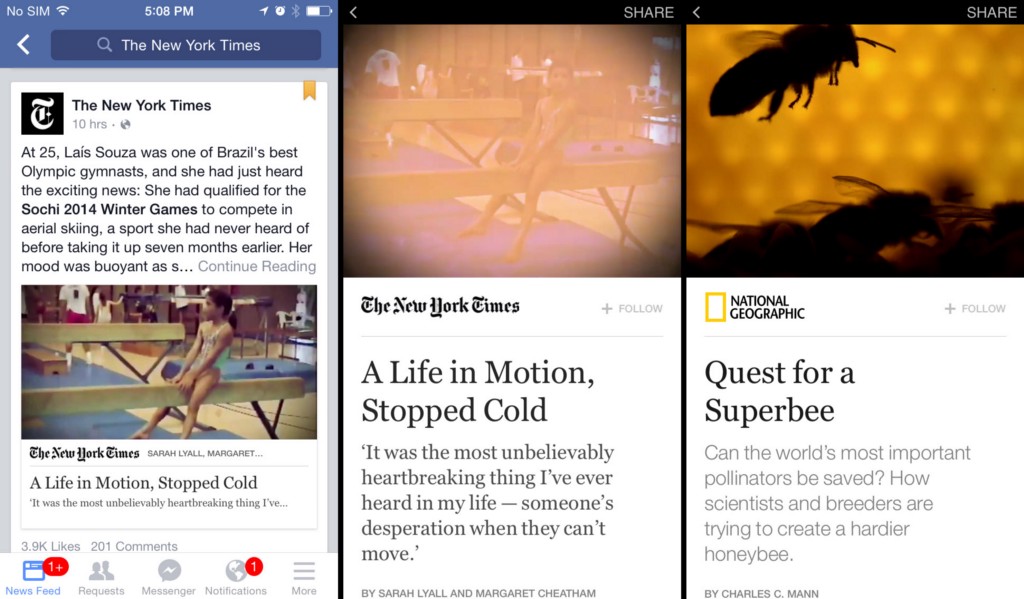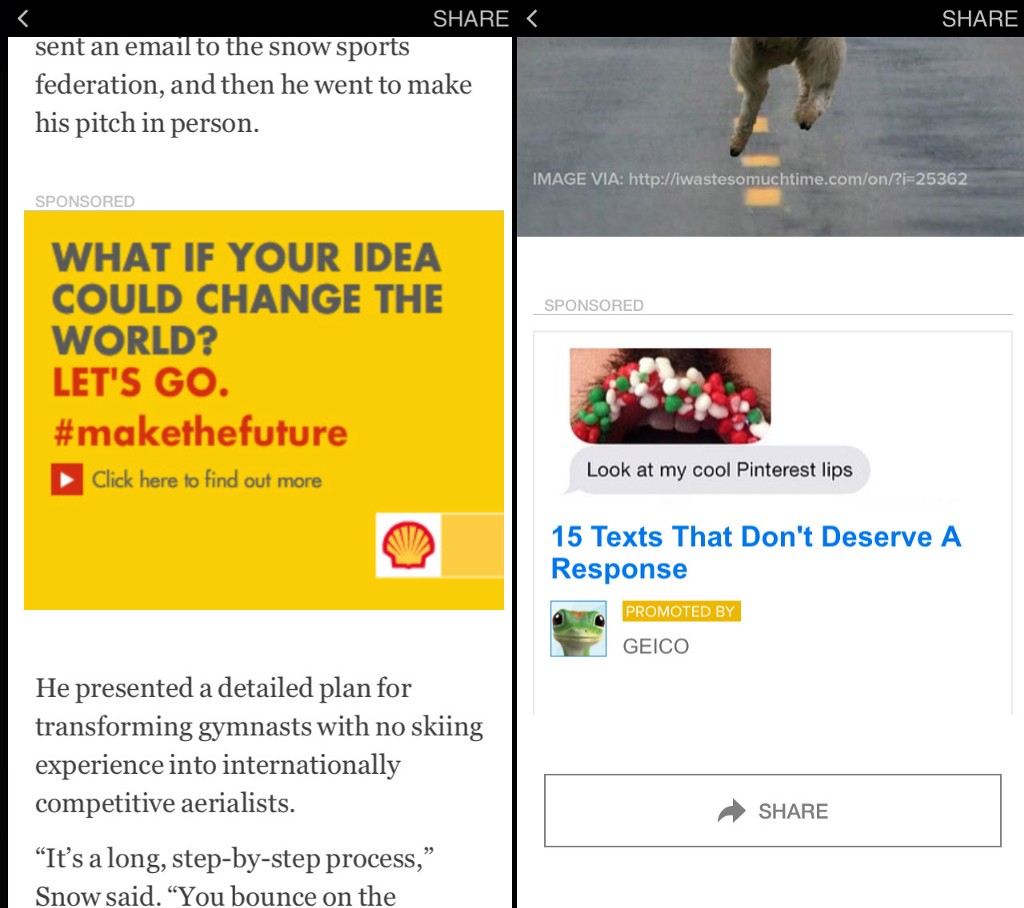Notes on the Surrender at Menlo Park

1. The manner in which Instant Articles are seen within Facebook’s News Feed is nearly as important as they way they’re hosted. Yes, they load faster. But the way they are previewed in the feed — differentiated fonts, auto-playing video — gives them a second advantage over everything around them.
2. The first batch of articles is very very very very long. This is as much a reflection of each institution’s anxieties as of its talents. Print publishers are jumping straight in with the long-formiest longform they have, as if to say, “look, Facebook will not interfere with our goal of publishing many very long and Very Good things.” (A little like Snapchat Discover’s first day!) The Times is leading with a terribly sad article about an athlete’s career cut short packaged behind a light curiosity-gap headline and teaser. The Atlantic is using its cover story, a ~9000-word article about a botched execution. NatGeo has a feature about breeding bees to survive the beepocalypse; NBC News, which is using the medium most thoroughly of the newsy group, has a story about almonds in California (they are bad). BuzzFeed has created what appears to be an attempt at the definitive viral post: a “13 Steps To Instantly Improve Your Day” that is really many posts in one, using every available Facebook publishing option (galleries, videos, long photos) to create something that feels like a choose-your-own adventure game in which every ending is Share This Article. The BBC and the Guardian haven’t posted anything yet.* Nothing from Spiegel or Bild, either.

3. Everything is overworked (for now). This always happens when publishers try new formats: It happened on Snapchat Discover, too, where publishers are gradually learning not to OVER-package their videos, because social media abhors conspicuous professionalism. (Conspicuous earnestness is fine, as long as it mimics the network’s local dialect.) This will be fixed when publications just start publishing everything.
4. The article previews display view AND share counts, regardless of what they are. (Update: View counts, which were displayed [seemingly erroneously] under the first posts, are no longer present. Read irrelevant thoughts about this at the bottom of the post!**)
5. In the beginning, having access to Instant will provide a huge advantage over publications that don’t. Eventually, publishers’ numbers will even out as competition increases. Easy traffic will be harder to come by, and certain tricks — as on the web — will wear out and become useless. This will be good in that it will prevent lazy behavior; this will be less good in that it will have transferred economic competition into an environment managed by one other company, which is itself engaged in a separate economic competition. What is a trick, or what is lazy, or what is clickbait or sharebait, is no longer an argument. It is a unilateral assessment (supported by data, of course — data produced and collected by the same company).
6. These articles exist within a separate parent interface in the app. If you tap the Times story, for example, it loads quickly underneath a slim black header bar. Scroll to the bottom and click a “related” story and it will open the Times website in the same frame, but will use that black bar as a loading bar, which moves in a non-linear way (slow at first, then faster). Not a very subtle suggestion! Also, maybe a temporary state of affairs: perhaps those related stories are only links because there isn’t enough native stuff to fill the boxes yet. Why, if you’re Facebook, leave open this pathway to the outside web?

7. That the first batch of stories is, like, MAXIMALIST PUBLISHING, leaves a few questions about advertising. Most of these stories have very few ads, which is flattering to the whole Facebook experience. The Times is showing me a small unit for Shell that looked a lot like a web article ad (blurry, bad, easy to ignore). BuzzFeed’s has an ad at the bottom, but it’s a display unit for one of its sponsored posts on its website. That is: It’s a display advertising unit (a banner ad, basically) for a piece of sponcon somewhere else. Presumably there is a lot we haven’t seen yet? (Facebook is letting publishers keep 100% of revenue for ads they sell, and 70% of what Facebook sells.)
Also: Facebook has spent a long time now trying to find ways to excise “low quality” content from its feeds, by which it meant, mostly, links to sites that hosted image memes but added nothing to them except a whole bunch of ads. What will Facebook think about a one-sentence Instant article with a blurry Minion meme embedded in it? Why give a publisher a share of that? What have they done to earn it, exactly? This, I imagine, could become a point of contention: Facebook’s attempts to define quality are more urgent when they’re the host. One advantage of a centralized internet is that you can easily banish people or behaviors; it is almost necessary, if you acknowledge that your particular platform is imperfect. So Facebook will be in the position of picking winners whether it wants to or not.
8. These stories, for now, only exist in the Facebook iOS app. If you share them on Twitter from within the app — which is an option — you will be sharing a link to web versions of these stories. As I understand it, publishers have basically been given an API for Instant, which they can use to more-or-less automatically export their stories to Facebook. Follow this through:
– Publishers want to publish directly to Facebook because it gives them greater access to Facebook’s users
— This belief in greater access is predicated on the idea that native Facebook stories will share better than linked ones
— If this is the case, and if all stories are co-published on Facebook, the result is that the near-entirety of a publisher’s Facebook mobile is hosted and monetized through Facebook (for some partners this is clearly the intention; for others, maybe not)
Facebook owns an enormous share of mobile traffic overall, meaning that any publication’s mobile web referrals were already composed largely of people coming from Facebook. With wider adoption, Instant would effectively remove Facebook from the mobile referrer pool, and mobile web traffic would plummet — for adopters, totally; for everyone else, more than they might expect. If enough partners use Instant, and if there is enough good Instant content to read, users will begin to regard linked-out stories as weird slow garbage that should Not Be Clicked.
9. Basically: Instant allows publishers to hand over nearly all of their mobile business to Facebook.
10. The Facebook app converts any link to a story with an Instant version to an Instant embed. I posted a link to the Times launch story — the web version — on Facebook. Viewed on mobile, this link was replaced with the Instant story. Makes sense! Remove the inferior version when possible. Death to links!
11. It’s a little weird to see publication employees in this Facebook ad for Instant? Like, some people, sure. But hearing Chris Cox intercut with James Bennet, EIC of the Atlantic, who says, “that’s what’s shareable, good stories are shareable,” before a software montage and a Facebook logo, is………………………………… HMMMM???????

12. Facebook has spent the last few months negotiating with publishers and has made a number of concessions: in response to worries it might cut off audience analytics, it is allowing for third-party analytics, including Quantcast, to tag Instant posts; in response to worries that it would take too large of a cut out of advertising, it is providing friendly rates (though the 100% figure is only accessible to publications large enough to sell ads directly, which is a fairly high threshold); in response to worries that such an arrangement might disintegrate a publication’s identity, they are allowing for custom article styling and fonts; in response to worries that Facebook would capture too much of publications’ businesses, it is allowing sponsored posts. You might characterize this as cautious behavior! Or as friendly. But consider the power differentials between “partners” here. Concessions that mean a great deal to publishers mean virtually nothing to Facebook. Facebook could afford to pay publishers 100% of all ad revenue into perpetuity if it wanted to. Facebook could probably buy every single one of its Instant publishing partners outright! Tomorrow!*** These are less concessions than symbolic assurances that Facebook is not a malicious actor. Almost any arrangements, formal or informal, between Facebook and publishers could be declared invalid or irrelevant whenever Facebook chooses, especially if Facebook’s macro internet situation changes.
To Facebook’s credit — in Facebook’s defense??? — the existence of this power differential makes even good-faith efforts difficult to take as such. But also irresponsible! Every single person in leadership at Facebook could be absolutely committed to the future of journalism and there would still be reasons for caution: all platforms have ideologies, even when they try not to; the internet changes very quickly, so anchoring yourself in one place is inherently risky; Facebook became the most important company in media in a few short years and the next Facebook will probably do the same; above all, Facebook is an advertising company that answers to its shareholders.
And to the various Facebook employees who have expressed surprise and disappointment, in public and to me directly, at the constant criticism their company receives: It’s not about you. It’s not about your ideals. It’s about a reasonable concern, based on the history of the internet and the modern economy in general, that the priorities of powerful partners usually change, eventually, in the partners’ favor. That this seems complex and mystifying from both sides of this arrangement is an example of the incredible power of professional rationalization.
13. Some future controversies we can look forward to: differences spotted in web versions and Facebook versions of articles; publications exceeding vaguely defined standards for, say, violent content; image rights issues (the DMCA never imagined this scenario in its wildest nightmares). Haha, sex stuff. Have you SEEN Facebook’s “community standards?” Facebook is very prudish, historically! Many, many discussions about the ideological opacity of T H E A L G O R I T H M. Idk, some other stuff. It will be crazy-making for all kinds of people. Lots of tweets. Can’t wait!
14. Now that we can see Instant in action,**** we can more clearly see what constitutes a publication on a Facebook-centric internet. A Facebook publication is… a brand? A “vertical?” It doesn’t own its distribution, it doesn’t meaningfully control its sources of revenue. It has no “design” outside of its individual articles. It is composed entirely of its content, as represented to Facebook users by Facebook. A lot of institutional advantages sort of evaporate. What is the difference, from the outside, between a large publication and a small one? One with a hundred reporters and one with ten? One with bureaus all around the world and one with a single office? One with strong institutional politics and one without? These distinctions are to be expressed through Facebook, which means through the News Feed, which means… not very coherently at all. An internet intermediated by Facebook is one in which publications are constantly struggling to stay on the right side of a thin line: are they justifying their own existence on Facebook’s new terms, or are they just weird middlemen introducing inefficiency into a system in which they are very obviously guests? This is slightly worse than a channel relationship. Partners are not guaranteed any more space, or traffic, than they can earn within Facebook’s own structure. They are essentially Facebook users with special publishing tools, legacies, momentum, and an immediate need to make money. Or are publications…. celebrities? No. I mean yes, sorry! Definitely! Congratulations!
15. The selection of the first round of publications will suggest different things to different people. It is a small and prestigious group of large publications; you could average them out, if you wanted, to a center-left ideology. Their selection was probably mostly about demonstrating the platform to the fullest and signaling a certain level of quality. But it immediately poses the question: Who next? There were no outright partisan publications. There were also no token niche or independent publications. They mostly just started at the top. Again: fine! But joining the media means that people will care about decisions like this. These people will be both extremely annoying and extremely not wrong.

234875627839452. Or maybe this is all just a short detour for Facebook. The history of software and web platforms is instructive here: Platforms grow by incorporating the labor of users and partners; they tend, over time, to regard the presence of the partners as an inefficiency. Twitter asks developers to make a bunch of apps using its data, so people make a bunch of mobile apps, then Twitter notices that these apps are actually very important to Twitter, and so Twitter buys one of the apps and takes steps to expel all the other apps, rendering the job of “Twitter app developer” more or less obsolete. In this formulation, publishers are app developers: They are working not only for their own benefit but, in addition, to find ways to increase Facebook’s share of user attention and satisfaction. If they find ways to succeed, through the practice of journalism or some other sort of content production, Facebook will take note. Perhaps Facebook will then devise a way to compensate reporters, or content creators, directly, rather than through the publications they work for. Maybe they’ll just buy a publication! Or many publications. If Instant is a success then, like everything at a functioning technology company that wants to make money, it will be iterated.
45862170348957103946872039568270. This is unspooling into a more general complaint, but whatever. There is toxic mindset that permeates discussions not just about Facebook but about most accelerating, inevitable-seeming tech companies. It conflates criticism with denial and nostalgia. Why do people complain about Uber so much? Is it loyalty to yellow cabs and their corrupt nonsense industry? Or is it a recognition that, as soon as a company reaches its level of importance and future inevitability, it should be treated as important. A word of caution about Facebook is not a wish to return to some non-existent ideal time. Print media was broken, TV was broken, commercial and public radio were broken, local media was broken, web media was very broken. Understanding this — or even just assuming it to be true! — is understanding that it is imperative to seek out the manner in which your media is broken, and the pressures that keep it that way. Worrying about the details of the coming future is merely taking that future seriously. People who insist otherwise? They have their reasons.
23489572089345720938457029384570293845720938452asdkjf. One of the great triumphs of Silicon Valley is its success in framing its companies’ objectives as missions, and their successes as pure contributions to progress. This is a sentiment that would not stand quite so easily in most other contexts: the success of a single business does not map perfectly onto the greater success of the economy, which does not map perfectly onto any useful concept of human progress. Anyway, what were we talking about? This is all going to seem so insane in twenty years. Or two years.
19. Oh, right: So what happens when Facebook goes away? Are today’s publishers, by then, just portable content generators ready to be passed to the next platform? Or have they been replaced by something else entirely? There is apparently only one way to find out!
*This article originally misstated follower counts for the Guardian’s US and UK pages. Sorry and removed! I hope Facebook sends me to future content jail.
**Regarding view counts, which have disappeared, so who cares: “This is a small but interesting choice: It suggests that Facebook sees them as valuable indicators not just to publishers but to users. View counts are one of those things used differently by publishers and platforms: YouTube has them everywhere, even when they’re low; Facebook videos have them too. It was considered sort of scandalous for Gawker to display them next to articles in 2007. One of the things Gawker discovered was that people seem to like to click on things with higher view counts. Now, incidentally, BuzzFeed displays them to readers only sometimes, when an article is especially successful, which is less about trumpeting success than inducing another read. These numbers are a useful display of Facebook’s underlying math — sort of like its News Feed algorithm in miniature. A reader can see that a story has lots of views but not that many shares, or lots of shares but not many more views, or few shares and few views, or more comments than might be expected for its popularity. Readers will assign meanings to these things! And this is now part of the package, even for institutions — like the Times — that had never previously displayed views at all.”
***The ones that could be sold, at least.
****24 hours in, NatGeo (mutant bees) is handily winning the Instant share race.
The CONTENT WARS is an occasional column intended to keep a majority of CONTENT coverage in one easily avoidable place.
